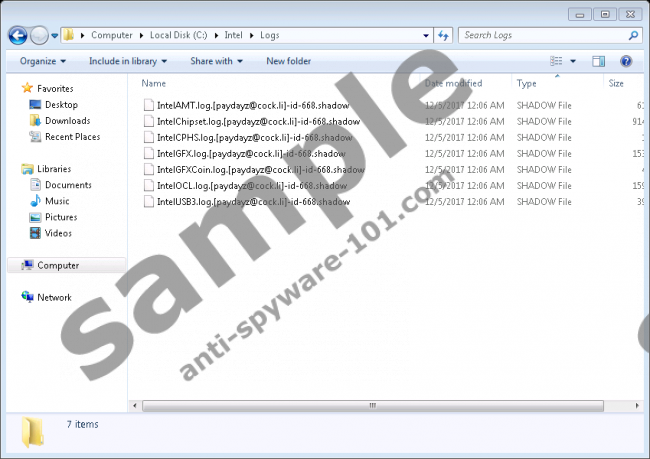What is Shadow Ransomware?
Shadow Ransomware is a vicious threat that may leave you with no working programs and none of your personal data. The malware does not exactly ruin any files, but it enciphers them with a secure encryption algorithm and without specific decryption tools such data becomes useless. To extort money from you, the threat’s creators should ask you to pay a ransom in exchange for a decryptor. No doubt they may sound quite sincere, but keep it in mind there are no guarantees they will keep up with their promises. There are plenty of users who got tricked while believing they could trust hackers and if you do not want to be one of them we would advise you to remove the malicious application. The instructions you can find a bit below the article should help you with such a task. However, if you are interested in getting to know more about Shadow Ransomware, we recommend reading the rest of our article too.

Where does Shadow Ransomware come from?
Shadow Ransomware might be spread with infected email attachments, malicious software installers, fake updates, or any other unreliable data downloaded from the Internet. Therefore, to avoid threats alike in the future, there are few tips you should always remember. For starters, if you receive an email from an unknown sender and it contains an attachment; it would be smarter no to open it. Even if it looks harmless, the file could still be dangerous because some infections disguise themselves as text documents, pictures, archives, etc. Moreover, when downloading software, users should make sure they are getting it from a reliable website. Unfortunately, various file-sharing web pages are not a good choice, so you should look for legitimate sites instead. One other thing we may recommend is having a legitimate antimalware tool. It might warn you about various threats, and you could use it to check suspicious data that raises a suspicion too.
How does Shadow Ransomware work?
According to our researchers at Anti-spyware-101.com the malicious application can encipher any file format. It means Shadow Ransomware can encrypt not just user’s personal files, such as pictures, photos, videos, etc., but also program data. Thus, most of the programs should crash during the encryption process, and you should be unable to relaunch them. The only good news is the malware does not target files located in the c:\Windows directory or else the computer’s operating system would be encrypted as well, and the device would be unbootable. The rest of the data that can be affected is supposed to be marked with a second extension, which consists of hackers’ email address, specific ID number, and “.shadow.” For example, files locked while we were testing this malicious application received “.[paydayz@cock.li]-id-867.shadow” extension.
After encrypting its targeted data, Shadow Ransomware should drop a ransom note called payday.hta in the %APPDATA% directory. The text on the mentioned document guarantees the user will receive decryption tools if he pays a ransom. It even suggests sending up to three small files for free decryption to make sure they have what they offer. If you have any important files that are not large, it may not hurt to try getting them decrypted this way. Nonetheless, we do not advise paying the ransom. Even if they give their word, there are no guarantees the hackers will do as they promise and you probably realize it yourself. Consequently, if you do not want to lose your savings in vain, we encourage you to remove the threat and find other ways to restore affected data.
How to delete Shadow Ransomware?
Since the malicious application might have appeared on the system after downloading and launching a suspicious file, the user should be able to get rid of it by merely erasing this file. Still, the task could appear to be a bit difficult for less experienced users, and so if you need any guidance, you should have a look at the instructions located at the end of this text. Another way to deal with Shadow Ransomware is to employ a legitimate antimalware tool. Keep in mind that if you had such a tool before it might be encrypted together with the rest of your data, which means you may need to reinstall it; as well as other ruined applications.
Eliminate Shadow Ransomware
- Tap Ctrl+Alt+Delete.
- Launch Task Manager and go to Processes.
- Search for a process related to the malware.
- Mark the suspicious process and click End Task.
- Press Windows key+E.
- Check the following paths:
%USERPROFILE%Desktop
%USERPROFILE%Downloads
%TEMP% - Locate the infection’s launcher (could be any recently downloaded file).
- Right-click the suspicious file and press Delete.
- Exit File Explorer.
100% FREE spyware scan and
tested removal of Shadow Ransomware*





0 Comments.